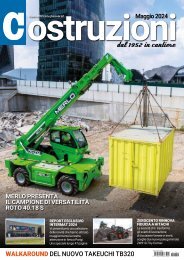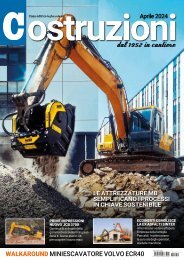LeStrade luglio 2020
SPECIALE - L’innovazione italiana che spicca nel mondo PONTI - Progetto di ripristino di impalcati in acciaio MATERIALI - Il lavoro di squadra tra emulsioni e bitumi
SPECIALE - L’innovazione italiana che spicca nel mondo
PONTI - Progetto di ripristino di impalcati in acciaio
MATERIALI - Il lavoro di squadra tra emulsioni e bitumi
- No tags were found...
Create successful ePaper yourself
Turn your PDF publications into a flip-book with our unique Google optimized e-Paper software.
54<br />
55<br />
LS<br />
10<br />
del tampone 11 in totale sicurezza. I piloni 10 e 11 sono stati<br />
fatti esplodere con un’operazione chirurgica, al di fuori dello<br />
scopo di lavoro della Fagioli. In più sono state effettuate<br />
operazioni di mitigazione e bonifica dell’area per la presenza<br />
di amianto e la conseguente demolizione degli edifici vicino<br />
al ponte. Operazioni non eseguite da Fagioli. Tre parole per<br />
riassumere l’intero lavoro:<br />
• Urgenza - per le operazioni di demolizione del rimanente<br />
ponte al fine di preparare l’area per la costruzione di quello<br />
nuovo e completato di recente, dove Fagioli ha eseguito<br />
le operazioni di trasporto e sollevamento delle sezioni;<br />
• Sicurezza - ogni singolo aspetto dell’intera operazione,<br />
168 giorni ininterrotti di lavori, è stato pianificato e dettagliato<br />
al fine di garantire il massimo livello di sicurezza,<br />
considerando la precarietà degli impalcati che sono rimasti<br />
dopo il crollo;<br />
• Ingegneria - Martinetti idraulici, gru cingolate, SPMT, torri<br />
di sollevamento... solo per citarne alcuni, sono stati i mezzi<br />
tecnologicamente avanzati utilizzati per eseguire l’operazione<br />
sulla base di centinaia di disegni tecnici e test funzionali.<br />
Nessun incidente è occorso durante i 168 giorni continuativi<br />
di lavori. nn<br />
12<br />
Made in Italy<br />
11<br />
poraneamente dal basso le travi a sbalzo dei piloni, in caso<br />
di eventuale cedimento strutturale. Le travi di supporto, posizionate<br />
sotto i piloni, applicavano un carico verticale verso<br />
l’alto di circa 600 ton al fine di garantire un riequilibrio dei<br />
carichi. Le torri di sollevamento e le travi di sostegno sono<br />
state quindi progettate per due diverse combinazioni di carico:<br />
il primo chiamato di "servizio", con carichi imposti dal sistema<br />
idraulico sulla struttura in cls pari a 600 ton per coppia<br />
di torri e il secondo chiamato "eccezionale" con carichi<br />
imposti sulla struttura pari a 2.400 ton per coppia di torri. Al<br />
fine di aumentare la precisione e monitorare costantemente<br />
il carico trasmesso alla struttura in cemento armato, è stato<br />
adottato anche un sistema di lettura con celle di carico, con<br />
una precisione dello 0,5%, con letture H24, 7 giorni alla settimana.<br />
Il sistema era montato alla base di ogni martinetto.<br />
Quest’operazione di ancoraggio ha consentito la rimozione<br />
10, 11, 12. Un intervento<br />
critico: il tampone numero 11<br />
English Version<br />
The Dismantling Phases<br />
of the Piles in the Western Area<br />
Once the beams were removed, the work continued with the<br />
disassembly of the piles. This activity was carried out by making<br />
longitudinal cuts in the concrete structure, about 36 m<br />
long with thickness up to 3 m. The whole concrete structure<br />
was divided into 3 large blocks with a weight suitable for lifting<br />
by means of two Fagioli Demag CC-2800 crawler cranes,<br />
in SSL configuration, with 78m boom, Superlift 300 ton at 13m.<br />
Due to the shape of the pile, before it was cut, it was necessary<br />
to support it with the cranes, which maintained, for the<br />
entire duration of the cut, a weight close to 100% of its weight.<br />
The “coring” systems allowed Fagioli to obtain specific holes,<br />
in order to facilitate the surgical operations of disassembly.<br />
All the blocks obtained from the sectioning of the piles, once<br />
at ground level were removed by means of Fagioli SPMTs.<br />
Removing the Berger Beam 11<br />
on the Eastern Side<br />
For what concerned the two piles on the Eastern side that survived<br />
the collapse of the third, they were much higher and more<br />
complex to be handled compared to the piles of the Western<br />
side as they were cable-stayed with large cantilever beams.<br />
No. 3 pairs of Fagioli lifting towers were erected, two for pile<br />
10 and one for pile 11, each 50m high, positioned on specifically<br />
cast concrete foundations.<br />
The lifting towers, had the function of temporarily supporting<br />
the three cantilever beams of the piles from below, in the event<br />
of structural collapse of the stays. The support beams also applied<br />
a vertical load upwards of about 600 tons to ensure a rebalancing<br />
of the loads. The lattice lifting towers and beams<br />
were therefore designed for two load combinations: the first<br />
called “service”, with loads imposed by the hydraulic system on<br />
10, 11, 12. A technical<br />
challenge: the beam no. 11<br />
the concrete structure equal to 600 tons per pair of towers and<br />
the second called “extra-heavy” with loads imposed on the hydraulic<br />
system from the concrete structure equal to 2400 tons<br />
per tower pair. In order to increase precision and constantly<br />
monitor the load transmitted to the reinforced concrete structure<br />
a reading system with load cells was also adopted, with an<br />
accuracy of 0.5%, with readings H24, 7 days a week. The system<br />
was mounted at the base of each jack.<br />
The securing operation allowed the removal of Berger beam<br />
11. Piles 10 and 11 were exploded with a surgical operation (operation<br />
not executed by Fagioli). Operation of Mitigation and<br />
reclamation of the area were executed for the presence of asbestos<br />
and the demolition of the buildings around the bridge<br />
(out of Fagioli scope of work).<br />
Just three words to summarize the entire job:<br />
• Urgency - to demolish the old bridge in order to prepare for<br />
the new one for which Fagioli was called for the transport and<br />
installation of the main sections;<br />
• Safety - Every single aspect of the whole operation (168 uninterrupted<br />
days), was planned and detailed in order to guarantee<br />
the highest level of safety, considering the poor conditions<br />
of the remaining bridge sections;<br />
• Engineering - Tower lift system, strand jacking systems,<br />
crawler cranes, SPMTs.. just to mention a few, were the technological<br />
advanced means used to execute the operation after<br />
hundreds of engineering drawings and calculations.<br />
This challenging project consited in 168 days of uninterrupted<br />
work with zero accidents. nn<br />
7/<strong>2020</strong> leStrade<br />
7/<strong>2020</strong>


















